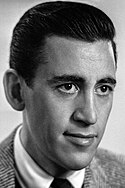J.D. Salinger Quote
Girls with their legs crossed, girls with their legs not crossed, girls with terrific legs, girls with lousy legs, girls that looked like swell girls, girls that looked like they'd be bitches if you knew them. It was really nice sightseeing, if you know what I mean. In a way, it was sort of depressing, too, because you kept wondering what the hell would happen to all of them. When they got out of school and college, I mean. You figured most of them would probably marry dopey guys. Guys that always talk about how many miles they get to a gallon in their goddam cars. Guys that get sore and childish as hell if you beat them at golf, or even just some stupid game like ping-pong. Guys that are very mean. Guys that never read books. Guys that are very boring— But I have to be careful about that. I mean about calling certain guys bores. I don't understand boring guys. I really don't.
Girls with their legs crossed, girls with their legs not crossed, girls with terrific legs, girls with lousy legs, girls that looked like swell girls, girls that looked like they'd be bitches if you knew them. It was really nice sightseeing, if you know what I mean. In a way, it was sort of depressing, too, because you kept wondering what the hell would happen to all of them. When they got out of school and college, I mean. You figured most of them would probably marry dopey guys. Guys that always talk about how many miles they get to a gallon in their goddam cars. Guys that get sore and childish as hell if you beat them at golf, or even just some stupid game like ping-pong. Guys that are very mean. Guys that never read books. Guys that are very boring— But I have to be careful about that. I mean about calling certain guys bores. I don't understand boring guys. I really don't.
Related Quotes
Ladies and gentlemen, when you paint your lips, eyes, nails, hair, side-beards, or whatever, to look beautiful or handsome, don't forget your up stairs, if you don't go up there to put things in order...
About J.D. Salinger
The Catcher in the Rye (1951) was an immediate popular success; Salinger's depiction of adolescent alienation and loss of innocence was influential, especially among adolescent readers. The novel was widely read and controversial, and its success led to public attention and scrutiny. Salinger became reclusive, publishing less frequently. He followed Catcher with a short story collection, Nine Stories (1953); Franny and Zooey (1961), a volume containing a novella and a short story; and a volume containing two novellas, Raise High the Roof Beam, Carpenters and Seymour: An Introduction (1963). Salinger's last published work, the novella Hapworth 16, 1924, appeared in The New Yorker on June 19, 1965.
Afterward, Salinger struggled with unwanted attention, including a legal battle in the 1980s with biographer Ian Hamilton and the release in the late 1990s of memoirs written by two people close to him: Joyce Maynard, an ex-lover; and his daughter, Margaret Salinger.
